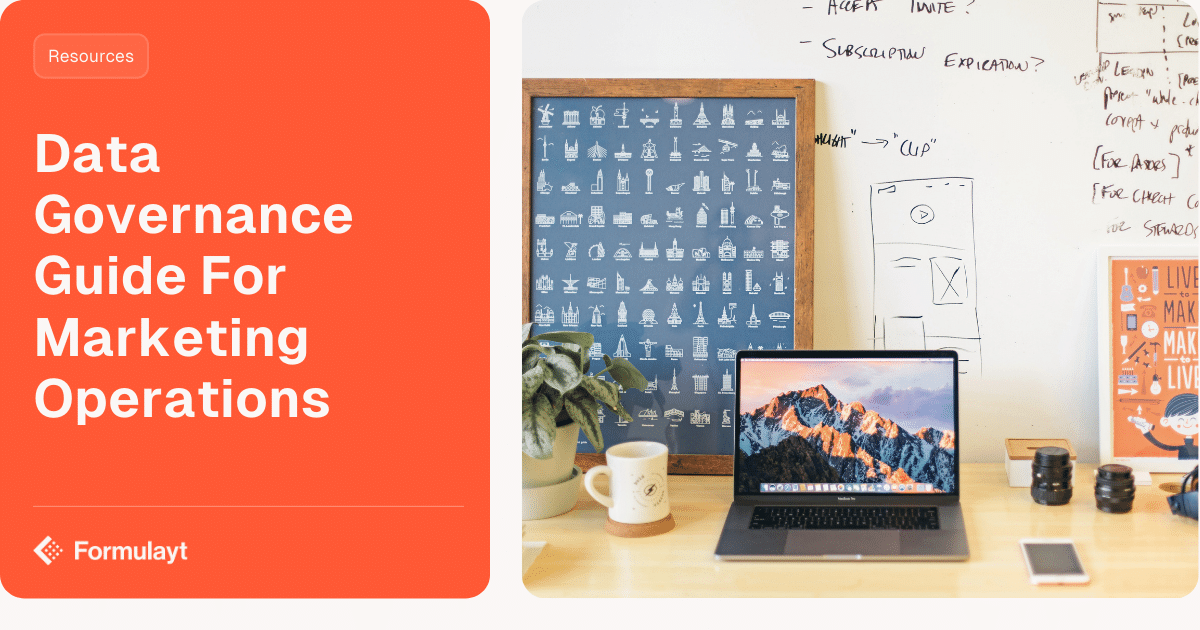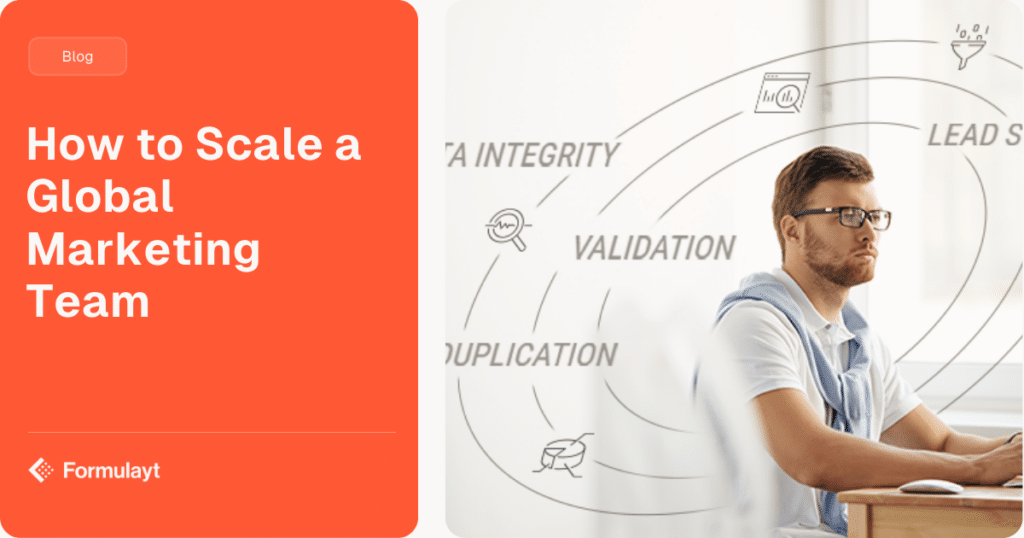The Essential Data Governance Guide For Marketing Operations

Data governance is the collective practice of gathering user details through a set of different roles, company processes and data standards to help an organisation achieve its goals.
In many organisations, the responsibility of data management and use has fallen between the IT department, the operations department and the marketing team. We’re here to help your business make better sense of how it should work.
In this essential guide to Data Governance, we look at the multitude of areas you need to consider when creating a data governance strategy for your enterprise.
Why is Marketing Data Governance important?
Through various routes of collecting data, companies can find out a range of attributes to a customer, such as name, email, company name… the list of data can go on and on. But how you store, handle and share this information is increasingly managed through complex data laws on national and global levels.
Customer data, lead data and buyer behaviour data are all key to growing your business. By obtaining and keeping data, organisations can build a persona for their key markets and understand their customer targets.
Ultimately, utilising data in the most consistent manner should be integral to your business planning as this data holds the key to the success of your business. The efficiency across data management allows businesses to act on the data in order to grow and understand market behaviour.
A crucial aspect of every business, data governance is at the core of every successful business decision and infiltrates each area of business strategy. Data Governance is required to hit 2 important goals:
- Ensure that an organisation's information assets are securely, legally, functionally and efficiently managed throughout the enterprise to secure its trust and accountability
- Drive the legal and ethical standards that a business holds, and showcase those standards to its shareholders, customers, and wider industry
What are the Benefits of Data Governance?
4 steps to building and testing your Marketing Data Governance Strategy
There are four critical steps to follow when forming your data governance strategies:
Step 1: Mapping
Multiple applications of data often occur across large global companies. So identifying key sources of data collection and working to standardise this across your business plays an important role here. By standardising the data you are collecting, you are limiting inaccuracies that prevent it from being used across your organisation across teams and on a global level.
Step 2: Storage
Define the data collection points and analyse the best storage options for your data. Efficient data storage is often cloud-based allowing accessibility across your company, no matter what the department. It also allows security to be maintained at a high level, granting access at multiple security levels.
Step 3: Compliance
Data functionality must work within the ever-changing data laws that happen on a state, national and global level. Constant review of data laws will increase quality assurance and usage across a multitude of tasks and projects. Enterprise-wide data management drives compliance, ensuring data quality throughout the entire data structure.
Step 4: Testing
The strategy itself is often less important than the implementation. Working across multiple IT and marketing teams, often in multi-language forms, means that data collection can very quickly become obsolete. Standardise reviews as part of the initial strategy, establish how it can be scaled and trialled across regions to identify issues early on.


What Makes a Good Data Governance Strategy?
Because Data Governance provides a solid, overarching strategy for how your organisation obtains, stores and maintains data, it’s important that the strategy itself is sound. This means you’ve tested against issues that may arise in future.
Apart from security being a top priority, there’s another area that is key to the longevity of your strategy: scalability.
Scaling growth of data governance is often left out of the equation, added on as an afterthought to an often-lengthy document. There are multiple dangers here — including the ability to forget the basic strategy in the first place, as well as scaling the growth of that strategy as you reach global levels of data gathering. Here are steps you should follow to properly navigate this:
Identify Data Access
Mapping roles and responsibilities, access and security and ultimately the department responsibility will guide how your organisation handles data governance. Creating a data access agreement adds a formal layer to your strategy, highlighting security levels and identifying which roles have ultimate responsibility for stored data.
Address Legal Barriers
Emerging data trends are currently being guided by data governance litigation. Data laws have been quite lax in the US until recently. However, CCPA is looming in California as data governance is rapidly expanding globally. A clear data storage and governance strategy will allow your enterprise to adapt and change with the varying layers of law as they come to affect your data.
Scale Data Systematically
The complexity of wrestling with huge quantities of data, especially when collected across multiple regions with language variants, is an area where additional tools can support. Through functional and user-friendly interfaces, these tools allow businesses to scale up data collection through a new way of deploying lead forms. Below we discuss tools further, but scaling and growing data sources is ideally reviewed by the data manager alongside an audit of support tools.
Grow and Maintain Quality
For acquiring new data and growing existing data, it’s important to understand the full range of data that organic lead capture can acquire. This can allow scaled growth that factors in the above objectives.
Suggested reading: Refer to the Essential Guide to Content Gating more info.
Operationalizing your data governance strategy
Now it’s time to put your data governance strategy into action. By this stage, you should have the following factors in order:
Who is responsible and for what
Cross-departmental groups should take the lead in large enterprise data governance planning. Whilst it’s useful to gain insight from the IT department, it should not only fall onto this team to provide technical advice and manage and govern data on its own. Organisations should consider electing a data governance board, data trustees and cross-business functional heads to lead the discussions. A data trustee is accountable for the security and privacy as well as the data quality and definitions used within the domain of data governance.
Building your framework
Apply a data maturity model to your current framework to see how it holds up. Make sure that your data framework includes all aspects of your larger business goals in data form. Reaching targets and maintaining clean data should be at the forefront of your framework. Make sure your framework is trustworthy, complete and generally understandable to all teams in the business.
Technology and tools
First, get your data under control. Once you do, take full advantage of its value by scaling the audience to reach everyone in a clear and concise manner on a global scale. The process of data governance can often lead to a bottle neck – clogging the data gathering with unnecessary steps. Free your employees of boring, repetitive tasks. Give them the tools to work simply and smoothly within your marketing and IT functions to truly access a data set that will see your business soar.
Although tools are not the singular answer to this issue, it’s essential that your data governance team understand the various solutions available, such as big data platforms, data warehouses, data lakes, ECM (enterprise content management) systems, quality solutions and data management solutions. Each of these are not necessarily required. However, when you do take on a new solution, be sure to factor in training costs within the budget to ensure full usage.
Training and monitoring
Every business is unique, and a detailed training and monitoring plan should be outlined by a data governance manager. Roles and responsibilities can be implemented more easily by identifying training requirements and continuously monitoring data management. As mentioned in the above section, tools and tech may require their own training. But there is also wider training across the entire organisation to implement – data handling, processing and storage are all areas that should run as regular training and management sessions for the appropriate team members.
How Formulayt can help
This guide may seem like a mountainous task to achieve a marketing data governance strategy that works for your enterprise. However, there are tools and tech to support you through each step. In our digital era, much of data collection relies on automation and support tools like Formulayt.
Improve your data governance
Our site offers tons of resources to help you plan your strategy. Book a demo to see how we can help you start or audit your data governance journey.
You may be interest in these article next
Double the ROI on Your Marketing Tech Stack
Too often, marketers focus on the deployment of a shiny new tool rather than focusing on maximizing the return on the tools they already For example, a company interested in increasing leads from their website might dedicate a sizeable portion of their marketing budget towards driving traffic from advertising. However, all the traffic in the…
How Form Inconsistencies Contribute to Data Hygiene Problems
Businesses have learned the importance of collecting data, but many are still unaware of how difficult it is to use if not governed properly. Here’s how to maintain data integrity.
How to Scale a Global Marketing Team
To organizing marketing data, the capturing of leads and collection of lead data needs to be carried out efficiently. However, creating web forms and landing pages can be challenging when you factor in the ever-growing needs of local marketing teams.



